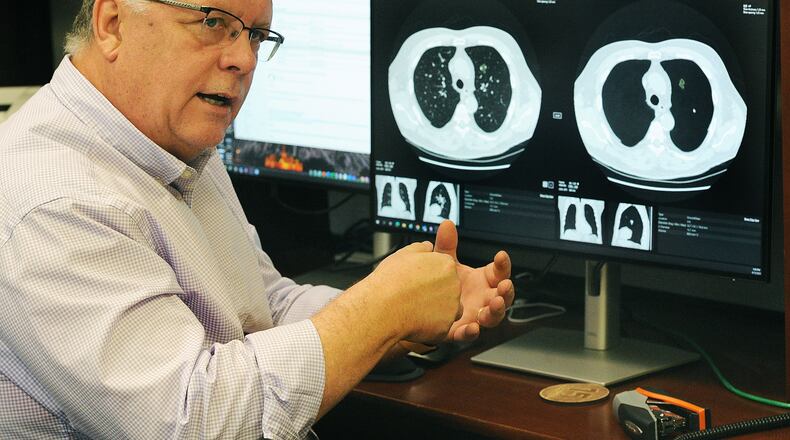Steve Worrell, chief executive of Riverain Technologies in Miamisburg, said the process of detecting lung cancer can be exacting. Many lung nodules show up as a “bright spot” on a chest or CT (or “CAT”) scan, he said. Many of those nodules are benign, appearing due to infection or reasons other rather than cancer.
But sometimes it can be challenging to tell right away. Multiple scans over time will often be needed to determine if a nodule is cancerous.
“First of all, do you have a lung nodule?” Worrell said in an interview at his company’s offices. “Second of all, is that lung nodule, if you have two successive scans, is it growing?”
A growing nodule may, tracked over time, point to the possible beginnings of cancer, leading to the decision to do a biopsy of part of a patient’s lung to be certain. It can be a laborious, worrisome process.
Radiologists can find themselves poring over “slices” of a scan or small, thin areas to ascertain whether a nodule — occupying perhaps a thousandth of a percent of the volume of an exam scan — is present.
Riverain’s AI tool can help diagnosticians and radiologists detect problem nodules faster and more precisely, Worrell said.
“It is literally that proverbial needle in the haystack,” the CEO said. “We help find it. Then we help characterize it. How big is it? What type of nodule is it?”
Once the tool characterizes the nodule, it then populates a detailed report, again saving time, he said.
“We’re basically about the detection,” he added.
The company says the tool is a “visual intelligence solution” that suppresses “noise” — removing what can be the distracting appearance of vessels or machine noise on a chest CT image to reveal the vital data.
VA medical centers nationwide have turned to Riverrain for that tool, which the company calls “ClearRead CT.”
Riverain said it has been selected to provide ClearRead CT to 22 VA hub locations and 87 spoke sites across the country, as part of the VA’s Lung Precision Oncology Program (also called “LPOP.”)
“They can basically take what we provide, and they can confirm it,” Worrell said of medical teams working with CT scans. “It sort of streamlines the entire process. It makes them faster. But also, it’s more accurate.”
About two-thirds of the company’s 32 employees work remotely. The talent that’s in demand in AI and computer sciences expect that kind of work flexibility, Worrell said.
In late 2020, the company moved from 3020 S. Tech Blvd. to a renovated, 8,200-square-foot space at 3130 S. Tech Blvd.
The new space provides the room the company’s equipment needs.
“We knew we were sort of setting out to grow,” Worrell said.
Nearly 8,000 veterans are diagnosed and treated by the VA for lung cancer each year, the department says. An estimated 900,000 are at risk for lung cancer due to age, smoking and environmental exposures during and after military service, the VA says.
“Veterans have a higher rate of lung cancer and a lower rate of survival than the general population,” the VA said on its website.
The LPOP program seeks to give VA clinicians the tools to address the problem.
About the Author


